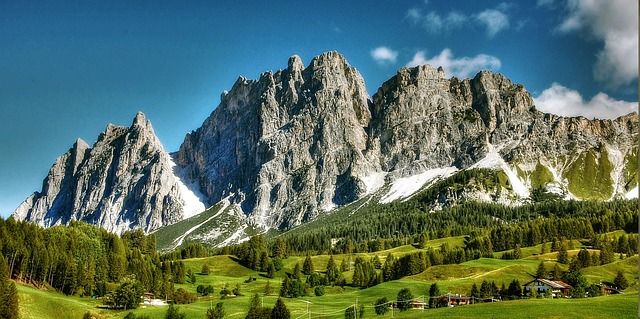
I felt like I was about to be hanged.
A sleepless night had been a lurid maelstrom of technicolour possibilities; dreams of wibbling on a busy route; being stuck with no option to go back; an exposed move at the top of The Ladder; falling, being inverted by the weight of my rucksack, pulled out of my climbing harness, plummeting head first like the start of the film ‘Cliffhanger’…
The scenic drive to Cortina d’Ampezzo over the dramatic Lagazuoi pass was overshadowed by a growing sense of my impending doom. As soon as we parked and I got out of the car and looked up at our challenge for the day – Via Ferrata Michielli Albino Strobel; 1000m (3000-ft) straight up the sheer, rock wall of Punta Fiames – I felt sick.
So sick that I had to run straight into the woods to vomit.
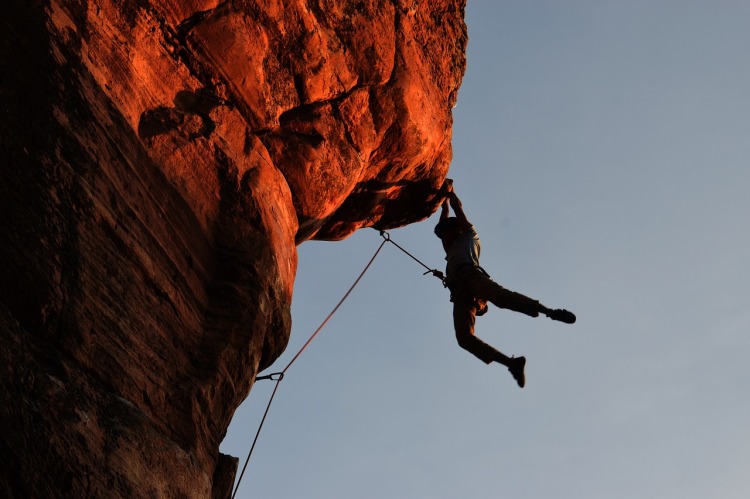
Located at the edge of the western Brenta Dolomites, Lake Garda is a mega-centre for climbers.
During our travels this year, we visited the birthplace of free climbing in the Saxon Swiss National Park. Arco, a town just north of Torbole on Lake Garda, claims to have invented Competition Climbing and hosts the prestigious, annual Rockmaster international competition. (Competition climbing is a new Olympic sport for 2020.)
The Via Ferrata, or ‘Iron Way’ is another form of climbing with its origins in the Dolomites. A Via Ferrata is simply a rock-climbing route equipped with fixed cables, stemples, ladders and bridges to offer the climber a degree of protection and assistance.
The climber wears an ordinary climbing harness connected to a ‘Via Ferrata kit’. A VF kit is two Karabiners attached to two lanyards. This allows the climber to unclip one lanyard at once to pass the stanchions affixing the VF cable to the rock. That way, the climber is safely connected to the cable at all times by at least one lanyard.
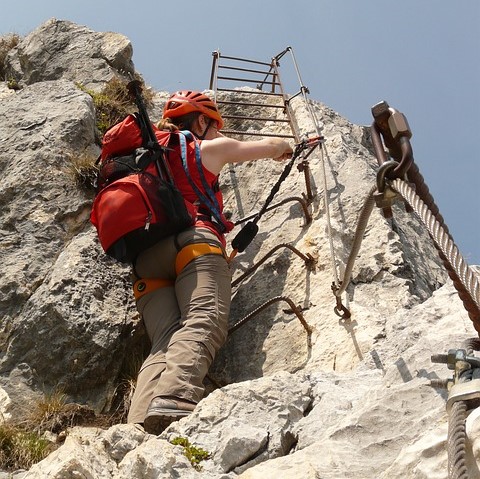
Vie Ferrate were originally used to assist the movement of troops during the brutal wars which raged in the Dolomite mountains between Italy and Austria during WW1. Now, however, Vie Ferrate give recreational climbers access to places that might otherwise be the province of gnarly, skilled, multi-pitch mountaineers.
Skydiving; Bungee Jumping; Aerobatics; Rock Climbing… As one of our many attempts to conquer a crippling fear of heights, Mark and I had the bright idea of spending a couple of weeks dangling off Vie Ferrate in the Dolomites.
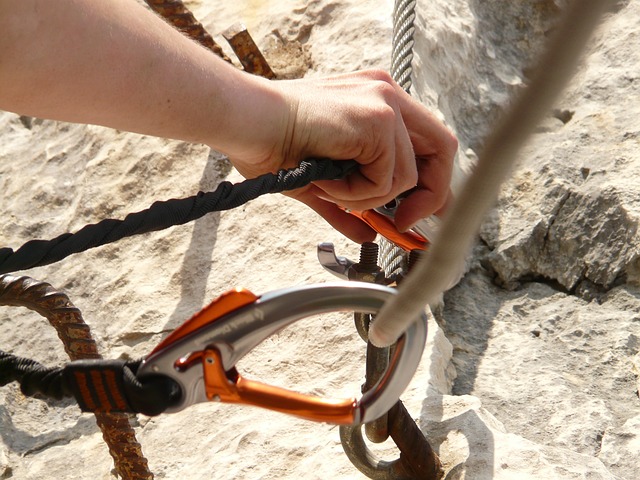
Back in Cortina, at the base of the climb, we repaired to a hotel for coffee and a stern chat. That morning, I had felt so sick with fear that breakfast had been out of the question. In anticipation of energy expenditure, I had force-fed myself a croissant en route, which was now sitting very uneasily on top of the coffee and the fear.
I disappeared to the loo to vomit for a second time and clearly didn’t look too good when I got back to the table. I was just about holding it together until my sister-in-law Grainne asked me “Are you OK?” and I just burst into tears. “Best not ask…” I sobbed. My brother, Mik observed “I think we might have a change of plan…”
Almost outside of my own body, I heard my smallest, most childlike voice say “But I really want to do it…”
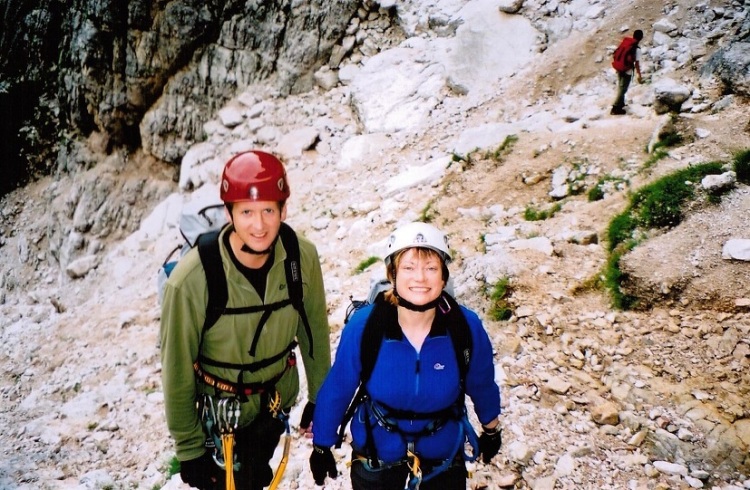
If I was in such a state in a café with my feet firmly on the ground, being able to climb the route looked unlikely. Once you start to climb a Via Ferrata, there is no going back. Mark was very nervous as well, so we agreed simply to walk to the start of the route with the guys, wave them off, then go and look at wild flowers for a couple of hours. Mark was all for leaving our climbing kit in the car so that there was no pressure on us. But me? Well. I don’t like to be thwarted…
I felt like the inflatable boy called in by the inflatable headmaster for taking a pin to the inflatable school. “You’ve let me down. You’ve let the school down. But worst of all – you’ve let yourself down…”
Which is why I said that we’d take our climbing gear, just so that we could have a peek at the route – and then decide if we wanted to do it…!
Mark tried to make me feel better on the approach, but I had to rush into the woods to vomit again. My brother said cheerfully “Well. It’s less weight to carry.”
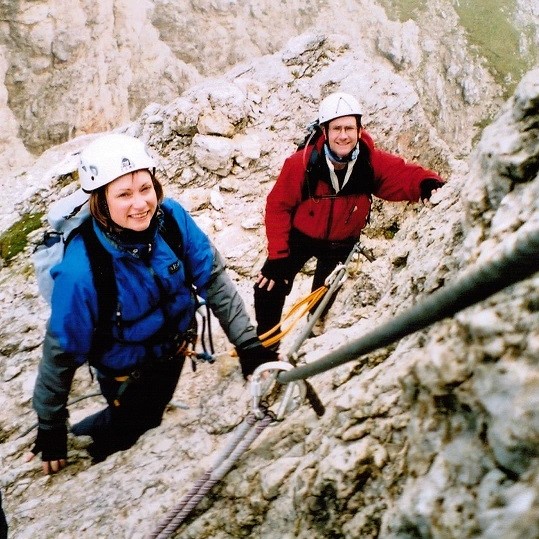
The walk up to the start was demanding. A long slog up a scree chute; it was steep and loose underfoot. My rucksack was very heavy with all my climbing gear plus three litres of water. (“Rehydrate or die!” – a survival technique that I learned rafting the Zambezi.) One benefit of Strobel is that it is lower and warmer than many of the other Vie Ferrate, so even though it was July, we were less likely to encounter snow. (Most Vie Ferrate in the Dolomites had been closed due to snow until a week previously.)
Mik read the riot act to me at the start of the route. “If you want to go, I am happy to guide but you must accept that once we have started we are committed. There is no possibility of turning back.” Never mind the people ascending behind you, down-climbing a rock climb when you can’t see where you’re putting your feet is, quite simply, not an option – in the same way as a multi-pitch abseil to who-knows-where.
Knowing this; we geared up.
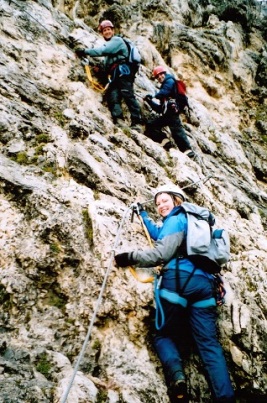
I fastened my climbing harness so tightly that I could barely breathe. Everyone who passed us was wearing a chest harness. Never one to overreact, I had a terrible fear that if I fell, the weight of my rucksack would invert me and I would fall head-first out of my waist harness…
Mik announced that the words for the day were “Bold”; “It’s Only a Grade 3” (out of 5) and “Old Biddy” – for the picture in the guide book of a lady on Strobel who was clearly well past the springtime of her youth. If she could do it…so could we.
However, in the back of my mind was always the knowledge that Via Ferrata Michielli Albino Strobel, was named in loving memory of a mountaineer who had been killed while climbing.
The first pitch was a scramble up on to a ledge. Then the first bit of Via Ferrata cable took us straight up a gulley. It looked OK; plenty of hand holds; although as ever, it was harder than it looked once you were on it. I had to focus only on the rock in front of me and forget about where I was. I coined my own phrase for the day; “Don’t look down…”
Our Guide Book said that it was fun to look down at the running track on the valley floor – a useful marker for your progress. It gets smaller the higher you climb. What fun! It already looked like a well-sucked polo mint. Personally, I didn’t see it on any part of the climb. My view of the running track had to wait until I looked back at the photographs.
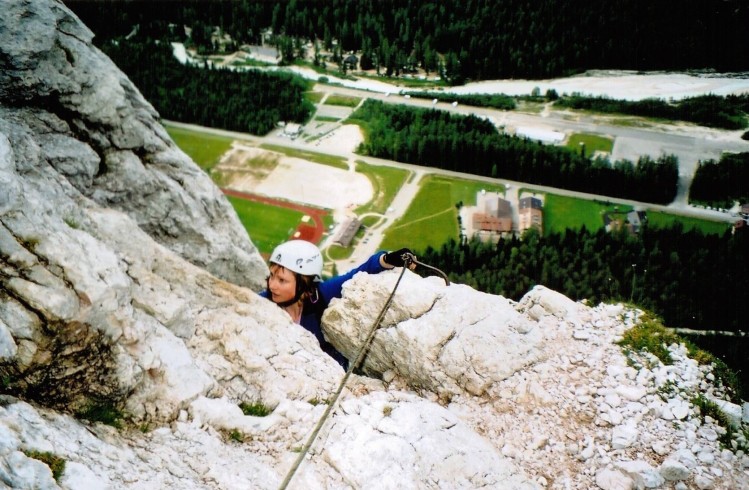
I concentrated on each 3-metre section of cable and just thought about my next move. There were always massive hand holds but sometimes a dearth of foot holds. I got a bit stuck early on without a foot hold, but Mik was reassuring and talked me through. I could feel panic bubbling up into full-blown terror, but I knew that I couldn’t allow it to take hold. It was not fair to put that on my brother, who had kindly offered to guide and in any case – there was no way out.
I amazed myself at how easy it was to overcome blind panic by simply determining not to let it run away with me. This was a real life lesson. Had there been any way at all to give up, I would have done so like a shot. Having no line of retreat is a huge motivator and shows that you can achieve more than you ever thought simply by putting your mind to it. The ONLY option available to me here was to take control. We would all be here, on this mountainside, until I figured out my next move.
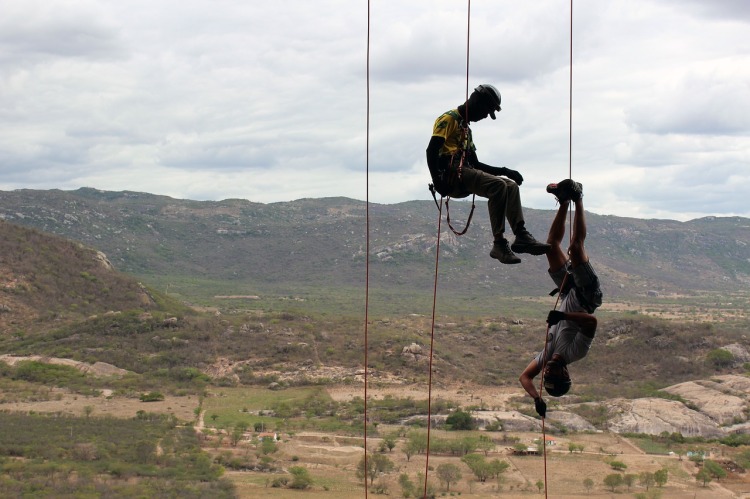
There were about four lengths of Ferrata along very exposed paths and one hideous traverse without any cable. That one will return forever in my nightmares. A narrow arrête about 20m long and no more than a metre wide, covered in loose stone. It was white. All white. Pure white stones the size of cricket balls to walk on with certain death on either side. A sheer gully dropped thousands of feet on the right side and the whole mountainside fell away to the left. With no cable, we had to walk across it with no safety – and thankfully, no wind.
I couldn’t even think about Mark; I was so terrified that my brain just went into shut down. I went across first. Obviously, I couldn’t look at the running track but I suspect that I would have needed a microscope by now. I didn’t look down, but even keeping my eyes fixed straight ahead, I had that dizzy, airy feeling that I was very, very high indeed. In mountaineering terms, that is known as ‘exposure’ – and my brother LOVES it.
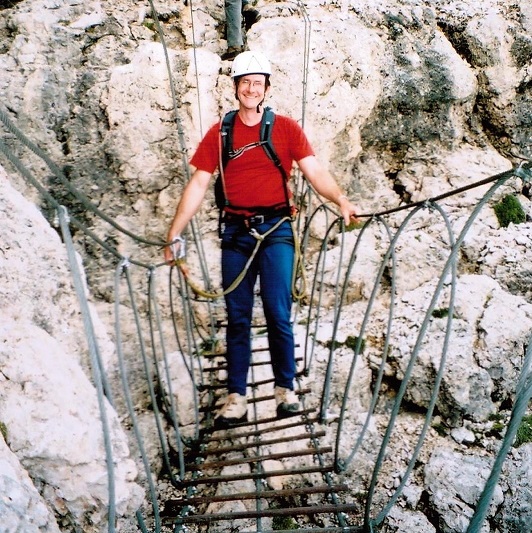
Once across, I looked back to see Mark, his face transfixed into a grimace, eyes staring sightlessly ahead while he took slow, stiff, shuffling pigeon steps with his hands out in front, like a tin automaton in a 1950’s horror movie. We made it, but we both knew that there was still the terror of The Ladder to go.
Some of the traverses were actually ‘pleasant’, with almost steps for your feet and jug handles for hand holds. I disliked the ‘Ups’ – a couple of sections which took drainage and, being limestone, were very slippery – slimey limey it is known in the Rock Jock business.
On one of these, some rude Germans closed in on us. I was stuck; struggling to find foot holds but I thought “Sod ‘em! They’ll just have to wait.” We let them past once I was secure. I couldn’t believe that they all clipped off the cable and clambered around us on such a precipitous section. They rewarded us shortly afterwards with a rockfall and didn’t trouble with the nicety of shouting “Achtung” or “Below”. This demonstrates neatly why one of the biggest dangers of rock climbing is OTHER PEOPLE.
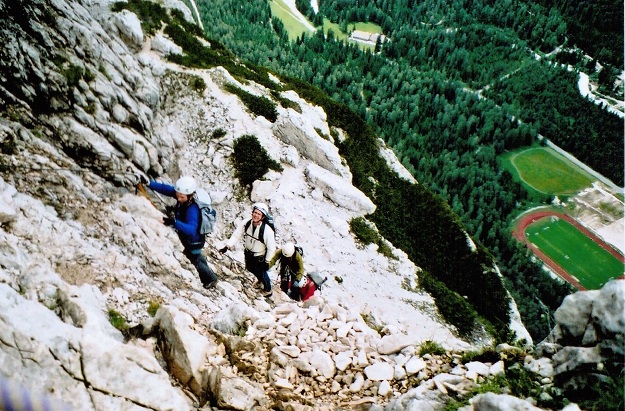
On about the third section of wire, I was quite physically and mentally exhausted and wishing it was all over. There was still The Ladder to navigate, which corkscrewed up the rock on to a section of stemples. The Ladder wasn’t as easy as you might think. The rungs were loose and one was bent – obviously from the loading of someone taking a fall. The exposure was immense. We had to step sideways to get on to The Ladder, which was above a seemingly bottomless chasm. It was like Touching the Void.
I couldn’t get my feet on the top rung as the rock wall was in the way. The stemples were widely spaced, requiring huge steps and some were just broken prongs sticking out of the rock. It affirmed the fact that if you fall, you may not die, but you would definitely hurt yourself. Badly. Gra did try to get me to smile for a photo at one point. I am not sure that I fully managed it. I had other things on my mind…
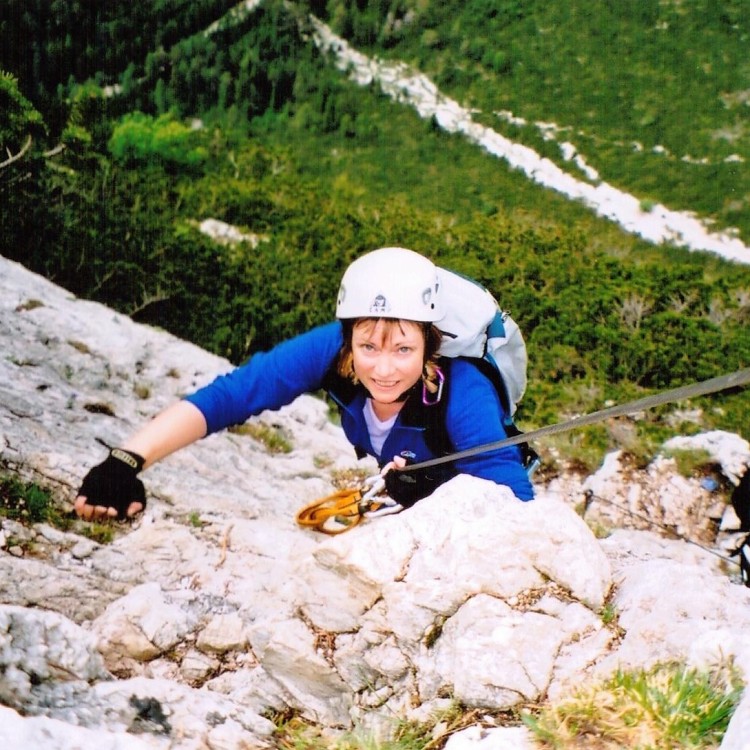
We had a slight rain shower but fortunately, the weather held. I really would not fancy doing this slimey limey route in the wet.
The last protected section over white limestone was lovely. It was really just a hands-in-pockets stroll to the summit at 2,240m (7,349ft). A couple of Alpine choughs sat in formation on the top, black against the white rock, their comic little faces looking expectant. I walked up to the crucifix on the summit and picked up a small stone; a keepsake of my proudest ever achievement. A 3000ft climb up a sheer rock face made my wobbly conquests in The Black Cuillin of Skye pale.
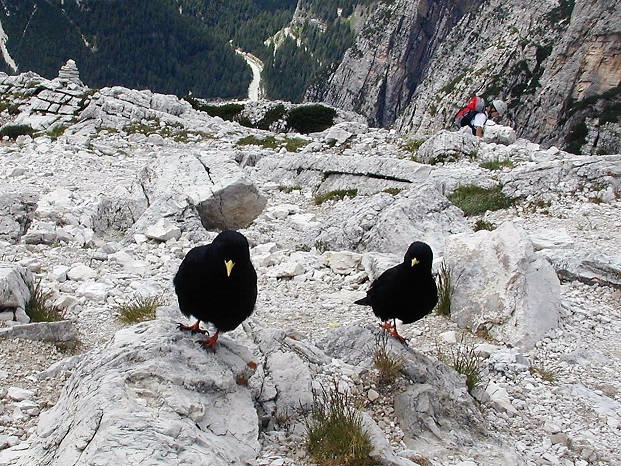
It took us three hours to complete the route. It had been three hours of unrelenting torment. I had never been so scared for such a sustained period of time – and I had never felt so exhilarated as I did when I got to the top.
It was fair to say that I felt chuffed up there with the choughs! The cables had made my hands smell metallic, rather like they always did after playing on the metal slides and roundabouts when we were children.
I managed to eat half a sandwich and a square of chocolate. The first food to have stayed down that day. We chatted to an English guy on the summit then decided to descend, as some weather seemed to be heading our way. The other peaks of the Dolomites looked sensational, particularly Col Rosa, opposite, which was absolutely livid red. Another 3B Via Ferrata but it looked horrid. Mind, so did Strobel when we had looked at it from ground level – yet here we were.
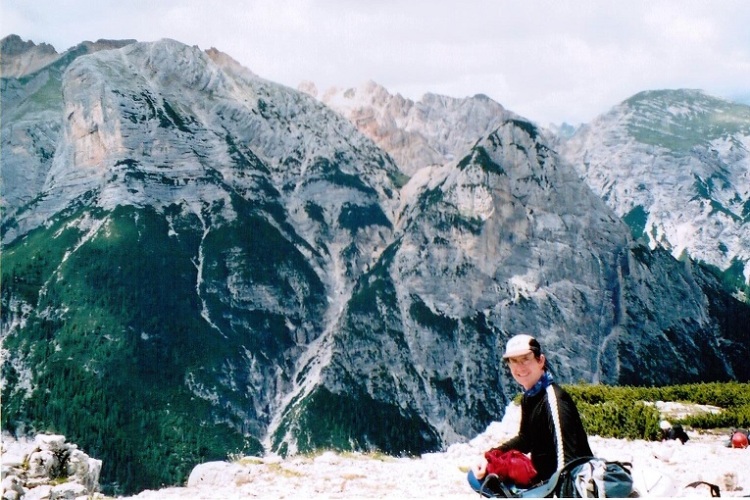
The descent had a sting in its tail. Mark and I were strolling down the path, holding hands, chatting and almost skipping. We had done the hard bit. We were relieved, exhilarated and busy congratulating ourselves when all of a sudden, the path narrowed to the width of a single boot, with a 50-foot precipice to the left. The English guy whom we had met probably wondered what was going on when we wibbled on this ‘easy’ bit and had to search out an alternative route. A bit like the looks of incredulity we got from the Collett’s Mountain Holidays staff when I had told them that we were afraid of heights but were planning on climbing Strobel!
Most of the descent was down a lovely scree. Then a traverse to the infamous running track, which finally, thankfully, looked normal size. We crossed through a beautiful meadow of wild flowers and back to Hotel Fiames for a well-earned beer. I felt very, very much better than I had eight hours previously.
Overcoming my fear of heights to climb Via Ferrata Michielli Albino Strobel was – and remains – the proudest achievement of my life.
And for that, I must give a a huge and resounding ‘THANK YOU!’ to Mik, Gra and Mark for .being so patient and putting up with all my nonsense.
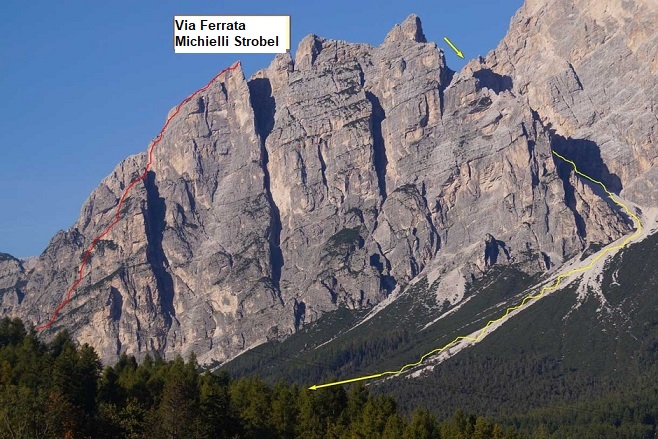
This year, I was delighted to be re-united with Cathy, my long-lost bestie from infant school. Despite a 45-year separation, our interests don’t seem to have diverged too far… I promised to write this blog for Cathy – since Via Ferrata is on her bucket list.
Cathy – I hope I haven’t put you off!
Want to Give Via Ferrata a Go?
- Get Into Via Ferrata – The Basics is a useful introductory article from the British Mountaineering Council, with links to details of what gear is required.
- If you would like to climb Via Ferrata in the Dolomites, Collett’s Mountain Holidays is a friendly, family-run company who specialise in trips to the area. We have used them several times for both winter and summer holidays and have never been less than delighted.
- If you would like to try a Via Ferrata closer to home, you could try Britain’s original Via Ferrata in Honister Slate Mine in the Lake District!
- Cicerone publish two excellent guide books covering the Via Ferrata in the Dolomites. Volume 1 covers the Vie Ferrate that we climbed on this trip (north, central and east ranges.) Volume 2 covers the western, Brenta Dolomites.
- Grammatical Note – Cicerone call them Via Ferratas. I prefer the Italian plural, Vie Ferrate, although unless I am in Italy, I would consider it pretentious to go into a coffee shop and ask for two cappuccini! I still cross out the ‘s’ on any menus offering panninis though. Double plural. That’s just WRONG – and don’t even THINK of slipping an apostrophe in there before the ‘s’..!
WWW – 5 Top Tips on Via Ferrata
- Get Proper Via Ferrata Kit – I definitely DO NOT recommend attempting a VF without proper VF equipment, which must NEVER have been loaded by a fall (so buy new, not 2nd hand and discard after a fall.) A VF kit MUST include a shock absorbing system. Two Karabiners and a bit of string is NOT adequate (and we did see this!)
- Rule 1 for Via Ferrata – ‘Don’t Fall’. Climbers’ ropes soften the impact of a fall. On a VF, a fall stops abruptly when the karabiners on your lanyards hit a metal stanchion after free-falling down a couple of metres of cable. For a normal-sized person, the forces loading the equipment in such a fall are roughly equivalent to stopping the weight of an elephant. Such forces are sufficient to break the equipment – or YOU if the equipment survives, which we hope it does… The shock absorbing system helps but the forces in a VF fall will still be much greater than in a climbing fall, so there is much more potential for injury. In Via Ferrata, The Force is definitely not with you!
- Don’t Underestimate Via Ferrata – VF allow you to reach remote mountain areas which otherwise, would probably be inaccessible. Although you always have the cable to haul on, the higher grade VFs require more technical climbing skills and may have few hand- and foot holds. Mik and Gra are both experienced rock climbers and Mik is a qualified Mountain Leader. As I say in the blog, VF’s are very committing – once you’ve started, you must finish! Unforeseen situations can arise. What is your plan if someone is injured but rescue is not available? If someone has fallen, their VF kit will be unsafe to re-use; what do you have as back up? What if someone is tired, scared or a section of the VF cable is broken? The question you need to ask is; whatever happens, could you get back safely under your own steam?
- Mountain Weather – The one predictable thing about mountain weather is its unpredictability – and your safety is basically two metal karabiners connecting you to a high-altitude lightning conductor! We experienced several spectacular thunderstorms while in the Dolomites. The advice if you are caught in a thunderstorm is to unclip from the cable and sit it out on your rucksack. So keep an eye on the weather!
- Exposure & Via Ferrata Grades – Via Ferrata are graded 1-5 with sub-categories A-C, depending on technical climbing difficulty, NOT exposure! Hence a Grade 1A VF could potentially be hideously exposed with sheer drops everywhere if the climb is not too technical. For someone who is scared of heights, this is the ONE thing that I really wanted to know, but was unable to find out before I went.
An Interesting VF Fact
Parts of the film ‘Cliffhanger‘ with Sylvester Stallone were filmed in the Dolomites above Cortina d’Ampezzo. The film is supposedly set in America, but my suspicions were aroused when I saw bridges and rock formations in the film that looked rather familiar from our VF trip!
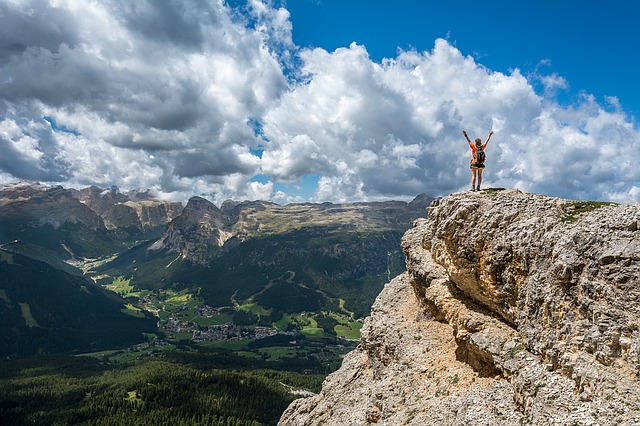
Do you miss postcards? I must be one of the few people who still send them. However, if YOU would like to receive a postcard from our travels, ‘Follow’ my blog and a post with pictures, like a little electronic postcard, will arrive in your inbox every week. How quaint!
Next time, join us as we go for a stroll in complete control!
Ohhhhhh. Reading that on a Sunday morning in our livingroom but feel less safe after reading your climbing adventure.
How brave that was,scared me reading it.
Love your travels so much.
LikeLike
Thank you for your kind words, John. Sorry to give you a scare on a Sunday! Our feet will be firmly back on solid ground next time…!
LikeLike
Wow I’m in awe! I once abseiled on a ridiculous management training course. Once was enough for me!
LikeLiked by 1 person
I said never again, but Grainne told me never say never!
LikeLike
Well done to the both of you – just reading this has made my stomach feel quite wobbly – not in a million years for me!
LikeLiked by 1 person
Thank you. It was a shocker, but I am really glad that I did it!
LikeLike